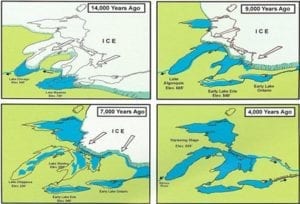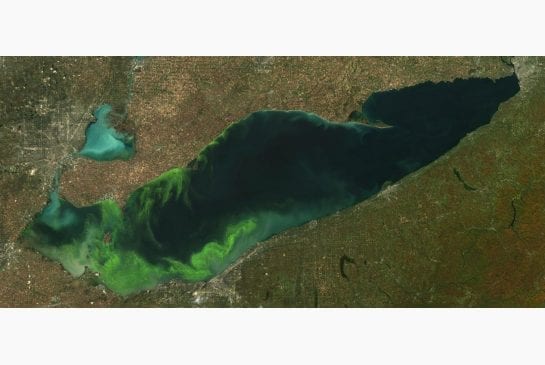Great Lakes experiencing ‘new stresses’ – CBC News, March 15, 2013

The image is from a March 14, 2017 tweet by Katherine O’Reilly @DrKatfish who writes: The lakes formed at the end of the last glacial period ~14,000 yr ago as retreating ice sheets carved basins into the land #GreatLakesWeek pic.twitter.com/JDCF0gjEDQ. Click on the image to enlarge it.
I have a particular interest in the Great Lakes in the preparations for the May 4 and May 5, 2013 Jane’s Walks in Long Branch that Mike James and I will be leading near the shoreline of Lake Ontario.
The following headline, photo, and opening sentences are from a March 15, 2013 CBC News report regarding the Great Lakes:
Great Lakes experiencing ‘new stresses’
Pharmaceutical waste, fertilizers and climate change all new threats to fresh water

The photo is from the March 15, 2013 CBC News report referenced in this blog post. The photo caption in the CBC report reads as follows: This satellite image shows blue-green algae on Lake Erie in 2011, the worst year for algal blooms on record. (Courtesy Essex Region Conservation Authority)
An aquatic expert warns that despite improved policies and extensive clean-up, the Great Lakes remain stressed and threatened.
Doug Haffner, the senior Canada research chair in Great Lakes Research at the University of Windsor, says a number of pollutant abatement programs implemented since the 1960s had a positive impact on the lakes.
“However, we have new issues. The Great Lakes have many different stresses on them right now,” Haffner said.
He said one newer concern is pharmaceutical waste.
Eighteen months ago, the International Joint Commission flagged “chemicals of emerging concern” as a risk to humans and ecosystems.
“The other factor is climate change,” Haffner said.
[End of excerpt]
A sidebar in the article lists the following chemicals of concern:
- Cosmetics
- Paints
- Electronics
- Fertilizers
- Fragrances
- Disinfectants
- Pesticides
The full article can be accessed here.
Another blog post related to the Great Lakes, with a focus on Along the shore (2013) and Sweet seas (2013), can be found here.
Also with regard to research related to water, a March 16, 2013 Globe and Mail article discusses the closing of a freshwater research station in Northern Ontario.
Algae in Lake Eries
A March 24, 2013 Toronto Star article highlights a toxic algae bloom affecting Lake Erie; a photo from the article is posted below. [Click on link in the previous sentence to access the article.]

Photo from March 24, 2013 Toronto Star article related to Lake Erie toxic algae bloom. Photo caption in the latter article reads as follows: NASA MODIS SENSOR / NOAA CENTERS FOR COASTAL OCEAN SCIENCE Satellite image of Lake Erie from Oct. 9, 2011, when the lake was afflicted with a very large bloom of toxi blue-green algae.
Invasive species
A March 27, 2013 Toronto Star article features an update regarding invasive species in the Great Lakes. The topic of invasive species is also highlighted in Sweet Seas (2013).

Leave a Reply
Want to join the discussion?Feel free to contribute!